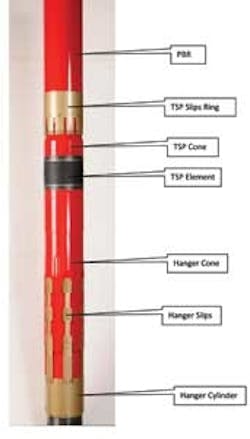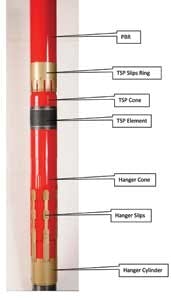Liner drilling technology reduces non-productive time
Complex drilling challenges often require unconventional solutions such as liner drilling to reach a successful outcome
Steven M. Rosenberg
Deepak M. Gala
Weatherford International Ltd.
It is a well-established reality that the world’s growing appetite for oil and gas is increasingly being fed from remote, deepwater fields and technically complex reservoirs. To mitigate the significant drilling challenges and operational risks that inevitably come with these locales, drilling engineers have to look beyond their conventional drilling techniques and consider novel well construction technologies.
In a relatively short time, liner drilling (LD) has proven itself as a reliable technology for addressing a host of drilling hazards in harsh environments, including lost circulation, depletion, wellbore stability, getting liner to bottom, and wellbore ballooning issues. LD offers several important benefits that help ensure the liner is set to its target depth:
- The technology creates a so-called “smear effect” in which the close proximity of the liner wall to the borehole smears cuttings against the formation, creating an impermeable wall cake and minimizing lost circulation
- This close proximity also results in considerably higher annular velocities for a given circulation rate compared to conventional drilling, which leads to better hole cleaning while drilling
- LD can require little or no hole preparation. The liner can be landed and cemented almost immediately upon reaching target depth with minimal delay for cementing operations
- LD helps reduce the rate of fluid loss in the annulus compared to conventional drilling operations, enabling annular fluid loss to be managed with a rig’s trip tank pump
- The rigidity of the liner being used acts as a stiff BHA, enabling maintenance of existing hole inclination and azimuth within the constraints of the well’s directional requirements
- Trip margin is eliminated, as there is no need for the liner to be pulled out of the hole
- No rig modifications are required; the same surface equipment used for conventional liner running operations is used for LD
- LD is used when required to mitigate a particular well challenge, allowing well construction to continue and minimizing NPT in the process.
These benefits have helped several Gulf of Mexico (GoM) operators achieve their drilling objectives, as the case histories below demonstrate.
Drilling through depleted sand
A deepwater GoM operator selected LD to drill through and isolate a pressured shale and depleted sand in a single-hole section. Conventional methods would require two strings of casing, which was unacceptable due to severe slimming of the wellbore.
Equipment Selection. A review of existing bit records and lithology information indicated that a three-bladed, 75⁄8-in. × 81⁄2-in. CWD bit with a thermally stable polycrystalline (TSP) diamond cutting structure would be best for this application. The CWD bit had 6-mm-round TSP diamond cutters pressed into aluminum blades containing high-velocity oxy fuel (HVOF) hardfacing, and a tungsten carbide gauge section to enable back-reaming. The bit was fitted with drillable and interchangeable copper nozzles to minimize damage to the subsequent shoe-track drill-out bit. The aluminum nose and cutting structure were fully drillable with conventional PDC or roller-cone bits, eliminating a costly drill-out trip.
A 4,260-ft, 75⁄8-in., 39-lb/ft Q-125 HYD-523 hydraulically set liner system was selected, which was designed for extended rotation periods in deep, high-angle applications and to allow for maximum workability during deployment.
The key for success with hydraulic liner systems is safe management of the circulating pressures. The premium liner is equipped with special mechanical locking devices, which are deactivated when the hydraulic setting pressure is reached. These devices prevent premature setting while running in the hole (RIH) and allow for the highest flow rates and pressures to be used, further aiding the workability of the system.
The hanger is set by applying hydraulic pressure to shear the pins in the cylinder, which forces the connector ring and slips up the cone and into the host casing; the liner’s weight is then transferred to the slips by lowering the running string.
The setting tool is used to rotate the liner when running in the well and during the LD operation. Hydraulic pressure, coupled with a ball-dropping event, shears the sleeve of the hydraulic cylinder on the setting tool so that it can be mechanically released. Drill pipe weight is slacked off to de-clutch the tool, which is then turned to the right to release the float nut. Hydraulic pressure is then re-applied to shear the ball from its seat in the liner wiper plug tool, thereby restoring circulation. The running string is then picked up to check that the setting tool is free, which is confirmed by the loss of the liner weight.
The packing element is designed to trap atmospheric pressure underneath it. Thus, as the liner system is lowered into the wellbore, hydrostatic pressure acts to vacuum it to the liner-top packer mandrel. This capability helps improve packer performance by preventing swabbing, premature setting and cuttings accumulation underneath the packing element.
The packer is set by raising the running string to expose the packer actuator, forming a no-go which is set down on the polished-bore receptacle (PBR). The no-go transfers weight through the PBR, shearing the pins in the packer and allowing the element and slips to be set in the host casing and the ratchet rings to lock in the compressive forces. A tieback completion PBR using a patented locking mechanism helps prevent the PBR from backing off when tight dogleg sections or high-debris environments are encountered.
LD operation. For the first section, the CWD bit and hydraulic liner hanger system were used to ream and drill the 75⁄8-in. liner a distance of 107 ft through the pressured shale and depleted sand. Existing 97⁄8-in. casing was set at 16,156 ft (4,924 m) MD with 60 degrees of inclination. The existing 81⁄2-in. × 97⁄8-in. hole was 20,419 ft measured depth (MD). The 4,260 ft (1,299 m) liner was washed and reamed from 20,320 ft (6,194 m) to 20,419 ft (6,223.7 m) MD and drilled in an additional 8 ft to 20,427 ft (6,226 m) MD.
The next hole section in the same well contained a 13.5-ppge pressured shale overlying the 7.7-ppge depleted pay sand. After drilling a 61⁄2-in. × 71⁄2-in. bi-center hole through the depleted pay sand, a 51⁄2-in., 23-lb/ft, Q-125, HYD-513 liner was reamed in using a 51⁄2-in. × 61⁄2-in. CWD bit. No mud losses were recorded while the 328-ft liner was reamed from 20,427 ft (6,226 m) to 20,519 ft (6,254 m) MD in the existing 61⁄2-in. × 71⁄2-in. hole. The LD system allowed the operator to successfully case off the depleted 92-ft (28 m) pay sand interval with no fluid losses, saving time and cost over conventional methods that had a low chance of success.
Casing challenges
A GoM shelf operator decided to case off an unstable shale section and a severely depleted 2-ppge sand with a 480-ft (146.3 m), 5½ -in. 23-lb/ft Q-125, HYD-513 liner at a wellbore inclination of 38°. A three-bladed, PDC drillable 5½-in. x 6½-in. CWD bit with TSP diamond cutting structure was selected for the LD operation. The operator required a 3½ -in. production tubing to ensure economic success, which necessitated a minimum 4½ -in. hole size to total depth after drilling out the 5½ -in. liner.
As part of the rotary string, the liner string would be subjected to typical borehole drilling forces and dynamics. Therefore, the 5½ -in. liner running/drilling tool system was specifically engineered with up to 38,000 pound force/feet (lbf/ft) of drilling torque capability. The tool’s release was controlled by hydraulic differential pressure across an internal ball seat in the setting tool, rather than between the inside diameter (ID) and outside diameter (OD) of the tool, which is the setting method common to conventional liner hangers and running/setting tools.
Liner reaming and drilling. During reaming, shale pack-off was experienced in the previously drilled shale intervals, requiring operator and service company teamwork to work the pipe through the shale intervals. In the second shale section from 13,759 ft (4,193.7 m) to 13,779 ft (4,199.8 m), as much as 55,000 lb of over pull was required to work the liner free. Pump pressure had increased to 1,686 psi, with surface torque measured as high as18,000 lbf/ft; however, no fluid was lost to the formation during the reaming operation.
The drilling operation required 10 hours to drill 19 ft of new hole (from 13,779 (4,199.8 m) to 13,798 ft (4,205.6 m) MD). Rotary speed ranged from 26 to 50 rpm, weight on bit (WOB) from 0 to 13,000 lb, and drilling torque from 8,000 to 9,000 lbf/ft. A 12.1 ppg WBM was used. After cementing the liner in place, an 18.3-ppge formation integrity test (FIT) verified that the 4½-in. hole required for the completion could be achieved. As in the reaming phase, no fluid was lost to the formation. No comparison how much fluid was lost on offset wells is available as this was one-off well.
Catastrophic thief zone
A GoM operator selected LD to case off a catastrophic thief zone, which was not possible using conventional drilling methods. Planning for the LD operation had to be completed within a 48-hr window to avoid rig downtime.
A three-bladed 95⁄8-in. x 12 1/4-in. CWD bit with TSP diamond cutting structure was selected, as was the premium 95⁄8-in., 53.5-lb/ft, HCP-110, SLIJ-II hydraulic liner hanger system highlighted in the first case study. A 13.4-ppg water-based mud (WBM) was used for the LD operation.
After the liner was successfully run to 7,069 ft (2,154 m) MD, the existing 12¼-in. hole was washed and reamed from 7,069 ft to 7,164 ft (2,183.5 m), at a rotary speed of 40 rpm, torque between 2,500 and 3,500 lbf/ft, surface pump pressure of 1,100 psi and a circulation rate of 500 gpm. Hook load readings verified that the open hole was in good condition. Liner washing and reaming continued to the bottom of the 12¼-in. section, at 7,367 ft (2,245 m) MD.
The liner was then drilled into a sand and shale sequence from 7,367 ft to 7,636 ft at an average rate of penetration (ROP) of 7.7 ft/hr and an on-bottom rotating time of 35 hr. There were no reported mud losses to the formation while LD and cementing the 95⁄8-in. casing. The liner hanger set without incident and the liner-setting tool was released and retrieved without problem.
Eliminate contingency liner
A GoM operator producing in the Carpa field offshore Mexico implemented LD after experiencing 39.65 days of NPT in an offset well. The NPT, with a total economic impact of $4.78 million, resulted from massive fluid losses of more than 2,500 bbl in a fractured limestone overlying the production interval. This caused stuck pipe and costly fishing operations, and raised the eventuality of running a contingency liner.
LD was implemented to case off the problematic limestone formation and land the 95⁄8-in., 53.5-lb/ft, L-80, Hyd-513 liner in the top of the producing formation, with no reported fluid losses. A five-bladed PDC bit that could be converted to a drillable drill shoe was used in this operation.
The CWD bit was designed to function as a PDC bit until total depth was reached, after which a ball-dropping event blocks the drilling nozzles from fluid flow. Pressurizing the casing string then shears the bit’s pins, displacing the steel blades and PDC cutting structure into the casing-hole open annulus and exposing the cement ports. The entire cutting structure is eventually displaced into the annulus and cemented into place.
Passive directional control was maintained in the 75° hole, using strategically positioned under- and near-gauge stabilizers in the LD bottomhole assembly (BHA). The CWD bit blades were displaced and the liner hanger and liner-top packer were each set with success. The operator saved $5 million and 40 days rig time by eliminating lost circulation and the need to run a contingency liner.
Complex thief interval
A GoM shelf operator drilling offshore Texas selected LD to deploy a 7-in. liner and case off a thief interval exhibiting varying degrees of lost-circulation through several adjacent blocks. Planning meetings between the service provider and operator resulted in the decision to drill a 7-in., 23-lb/ft HCP-110, GB CDE (casing drilling enhanced) liner through the catastrophic loss zone and set it in a competent shale below.
Liner setting tool.
A 7-in. × 81⁄2-in. CWD bit with a displaceable 13-mm PDC cutting structure was deemed the most suitable for the application. Its design features enabled the bit to be converted to a drillable casing shoe at total depth, allowing for shoe-track drill-out with conventional PDC or roller-cone bits.
As part of the planned LD procedure, a 95⁄8-in. production casing was set and cemented in place at 4,150 ft (1,265 m) MD, approximately 50 ft (15.24 m) above the known loss zone. This was followed by retrieval of the 8 ½-in. BHA, rig-up of the 7-in. liner-handling equipment and deployment of the liner. Approximately 30 hours were required to drill the 496-ft of new hole through the catastrophic loss interval and cement the liner in place. The liner was successfully pressure tested and the liner shoe was successfully tested to the required 11.5 ppge.
Conclusions
The case histories presented provide a clear indication of the benefits of LD technology in difficult drilling environments, including efficient and accurate liner setting in unstable lost-circulation zones, a reduced rate of fluid loss in the annulus compared to conventional drilling operations, and a favorable impact on NPT and overall cost reduction.
Importantly, the use of LD was identified as the only viable means for some of these operators to achieve their drilling objectives and avoid abandoning the well altogether. Complex drilling challenges often require unconventional solutions such as liner drilling to play a key role in a successful outcome.
Acknowledgment
This article is an abbreviated form of “Liner Drilling Technology as a Tool to Reduce Non-Productive Time: An Update on Field Experiences in the Gulf of Mexico,” presented at the 2011 AADE National Technical Conference and Exhibition in Houston.
Offshore Articles Archives
View Oil and Gas Articles on PennEnergy.com


